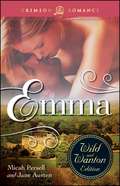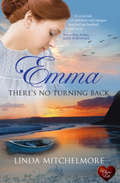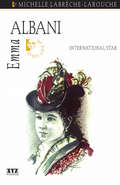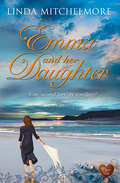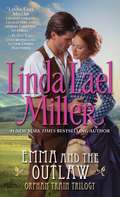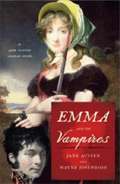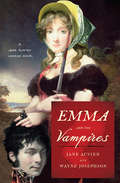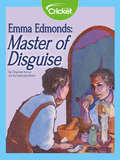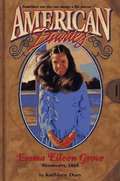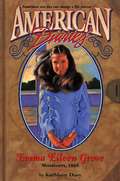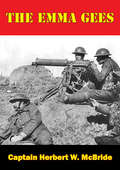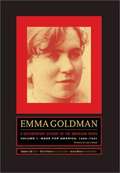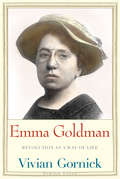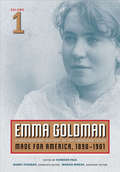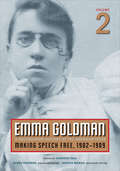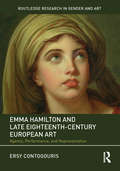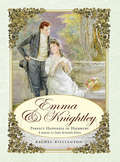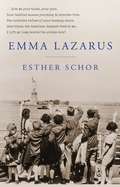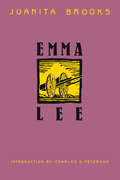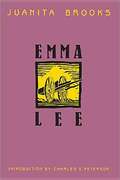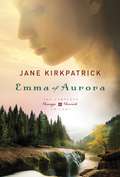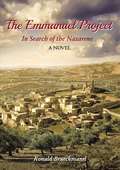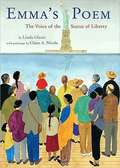- Table View
- List View
Emma
by Jane Austen Micah PersellEmma Woodhouse and Mr. Knightley won the literary world's heart 200 years ago when Jane Austen first penned the story of their friendship-turned-love.Emma is the young, rich, beautiful heroine with too much time on her hands and an overactive imagination; Mr. Knightley is her long-suffering friend who is always trying to steer her in the right direction. Their love story is one of deep, dedicated affection blooming into passion.But what about all of that sexual tension that crackles in the subtext? In this Wild and Wanton edition of Austen's classic, Emma and Mr. Knightley burn up the pages as they give in to their baser natures. Discover the sexy scenes that readers of Emma have been imagining between Austen's lines since 1815.Sensuality Level: Hot
Emma
by F. W. KenyonHistory has produced few women as fascinating as the auburn-haired beauty Emma, Lady Hamilton, who captured the heart of England's greatest admiral, Lord Nelson. Warmhearted, impulsive, amoral, she distributed her favors generously, mistaking gratitude and affection for love, rising with each of her "protectors" to her ultimate position of power in the glittering court at Naples-- until she at last met the one man she was to love intensely and forever. If ever two lovers were destined for each other, they were Emma Hamilton and Horatio Nelson, that passionate, brilliant woman, and that dynamic, heroic man. "You, my beloved Emma," Nelson once wrote her, "and my country, are the two dearest objects of my fond heart. All I have ever wanted in this world, have ever asked, ever sought, is one true heart. That I found in Italy, in my own dear Emma's beloved breast." Her love for Nelson was equally intense, and together they shared a romance all-consuming in its power. Across the prosaic pages of history the lovely Emma cast her glow. Her warmth and charm are here superbly portrayed by a writer who proves once again, as he did in his earlier bestseller, The Emperor's Lady, his immense gifts for capturing the essence of a living, exciting woman. Mr. Kenyon has been a successful writer since his first published story appeared in a New Zealand magazine in 1938. Born in England in 1912, he moved to New Zealand as a boy. His writing has included numerous radio plays, short stories, and magazine pieces. The Emperor's Lady was his first published novel, followed by Royal Merry-Go-Round.
Emma: There's No Turning Back
by Linda MitchelmoreThis British historical romance offers “a vivid tale of ambition and intrigue” from the author of Emma and Her Daughter (Kate Furnivall). Devon, England, 1911. Orphaned and scandalized in her hometown, young Emma Le Goff hasn’t had an easy life. Now she and her childhood sweetheart Seth Jago are set to marry, and for the first time in years, Emma is truly happy. But when Seth’s criminal brother breaks out of jail, his sinister presence brings back a troubling past. Meanwhile, Matthew Caunter, the charismatic man who came to Emma’s rescue in her hour of need, has also returned to Devon. Escaping to Canada may be the young couple’s only hope. But for Emma, the thought of leaving Matthew is almost impossible to bear . . . Award-winning author Linda Mitchelmore continues the tale of her “captivating young heroine” introduced in To Turn Full Circle (Margaret Kaine).
Emma Albani: Victorian Diva (The Quest Library)
by Michelle Labrèche-Larouche Darcy DuntonBorn in Quebec, Emma Lajeunesse studied in Europe and in 1869 at the age of 23 launched her opera career in Italy. Almost overnight she became Albani, the world-renowned diva.
Emma and Her Daughter
by Linda MitchelmoreAfter the turmoil of WWI, a wealthy widow returns to England—and the man who once stirred her heart. It is 1927 and the wealthy widow Emma Jago is returning from Canada to the windswept coast of Devon. While the Great War has left its mark on the place, and her teenage daughter Fleur can’t understand her nostalgic reveries, Emma remembers when Matthew Caunter waltzed her around the foyer of a now abandoned hotel. But Devon holds more than sweet memories. As Emma works to reclaim her home, an unwelcome visitor threatens to reveal a secret that could turn her new life upside down. Through it all, Matthew is never far from mind, but when he appears in the flesh—and as dashing as ever—she wonders if it is finally their time to be happy, or if it was truly never meant to be. The award-winning author of Emma: There’s No Turning Back, revisits these “lovely” and “warm” characters in this heartfelt historical romance (Sophie Kind).
Emma And The Outlaw (Orphan Train #2)
by Linda Lael MillerThe #1 New York Times bestselling author Linda Lael Miller continues the Orphan Train trilogy continues with this second book about a sizzling romance between the local librarian and a drifter with a price on his head.As the librarian of her frontier town in Idaho Territory, Emma Chalmers is prim and proper despite her unconventional upbringing by the local madam. She wouldn&’t even permit Fulton Whitney to kiss her, and they were practically engaged. But when Steven Fairfax landed in her home, wounded by an explosion at a rowdy neighborhood saloon, his lazy smile made Emma&’s blood race. Slowly, Steven stilled her fears with his gentle, insistent caresses...until at last, she gave herself unashamedly to the splendid passion that was their destiny. But Emma faces a new terror: the drifter she&’s come to love so desperately is a wanted man and his past is about to catch up with him.
Emma and the Vampires
by Jane Austen Wayne JosephsonWhat better place than pale England to hide a secret society of gentlemen vampires? In this hilarious retelling of Jane Austen's Emma, screenwriter Wayne Josephson casts Mr. Knightley as one of the most handsome and noble of the gentlemen village vampires. Blithely unaware of their presence, Emma, who imagines she has a special gift for matchmaking, attempts to arrange the affairs of her social circle with delightfully disastrous results. But when her dear friend Harriet Smith declares her love for Mr. Knightley, Emma realizes she's the one who wants to stay up all night with him. Fortunately, Mr. Knightley has been hiding a secret deep within his unbeating heart-his (literal) undying love for her... A brilliant mash-up of Jane Austen and the undead.
Emma and the Vampires
by Wayne JosephsonWhat better place than pale England to hide a secret society of gentlemen vampires? In this hilarious retelling of Jane Austen's Emma, screenwriter Wayne Josephson casts Mr. Knightley as one of the most handsome and noble of the gentlemen village vampires. Blithely unaware of their presence, Emma, who imagines she has a special gift for matchmaking, attempts to arrange the affairs of her social circle with delightfully disastrous results. But when her dear friend Harriet Smith declares her love for Mr. Knightley, Emma realizes she's the one who wants to stay up all night with him. Fortunately, Mr. Knightley has been hiding a secret deep within his unbeating heart—his (literal) undying love for her... A brilliant mash-up of Jane Austen and the undead.
Emma Edmonds: Master of Disguise
by Charnan SimonEmma Edmonds, a woman disguised as Private Frank Thompson, earned a spot in U.S. history as a successful Union spy during the American Civil War. At different times, she also posed as an Irish peddler woman, a black laundress, and a Confederate sympathizer.
Emma Eileen Grove: Mississippi, 1865 (American Diaries)
by Kathleen DueyTwelve-year-old Emma receives unexpected friendship from a Black roustabout and a Union soldier during an explosion on the steamboat Sultana in 1865.
Emma Eileen Grove (American Diaries)
by Kathleen DueyTwelve-year-old Emma receives unexpected friendship from a Black roustabout and a Union soldier during an explosion on the steamboat Sultana in 1865.
The Emma Gees [Illustrated Edition]
by Captain Herbert W. McBrideIncludes the First World War Illustrations Pack - 73 battle plans and diagrams and 198 photosThe classic account of sniping on the Western Front."Herbert Wesley McBride was a Captain in the Twenty-first Battalion, Canadian Expeditionary Force, during the First World War. He was a sniper and commander of a machine gun unit known as the "Emma Gees." He was also the author of two books on the war: "A Rifleman Went To War" (1933) and "The Emma Gees" (1918)...When the war started, he volunteered in a Canadian rifle company in Ottawa because he wanted to see action as quickly as possible. He was commissioned as an officer, but was reduced to a private due to several drunken incidents. He shipped to England for training and then to the Western Front, where he participated in battles around Ypres and the Somme throughout 1916. In his book, "A Rifleman Went To War," he recounts killing more than 100 German soldiers as a sniper. This book is highly regarded by students of riflery, it's mandatory reading in the U.S. Marine Corps Sniping School. It is also considered one of the best first-person accounts of World War I, often being compared favorably to "Storm of Steel" by Ernst Junger. However McBride notes in his book that by the end of 1916 he felt in his heart "the game was over," and a series of alcoholic binges resulted in his court martial and dismissal from the Canadian Expeditionary Force in February 1917. He then joined the United States Army's 38th Division, serving out the war as a marksmanship and sniping instructor at Camp Perry. He resigned in October 1918. After the war, he worked in the lumber industry in Oregon for most of his later years. He died in Indianapolis of a sudden heart failure on March 17, 1933, shortly after finishing "A Rifleman Went To War." He was 60."-Canadaatwar.com
Emma Goldman: A Documentary History of the American Years
by Candace FalkEmma Goldman: A Documentary History of the American Years redefines the historical memory of Emma Goldman and illuminates a forgotten yet influential facet of the history of American and European radicalism. This definitive multi-volume work, which differs significantly from Goldman's autobiography, presents original texts--a significant group of which are published in or translated into English for the first time--anchored by rigorous contextual annotations. The distillation of years of scholarly research, these volumes include personal correspondence, newspaper articles, government surveillance reports from America and Europe, dramatic court transcripts, unpublished lecture notes, and an array of other rare items and documentation. Biographical, newspaper, and organizational appendixes are complemented by in-depth chronologies that underscore the complexity of Goldman's political and social milieu. The first volume,Made for America, 1890-1901,tracks the young Emma Goldman's introduction into the anarchist movement, features her earliest known writings in the German anarchist press, and charts her gradual emergence from the radical immigrant circles of New York City's Lower East Side into a political and intellectual culture of both national and international importance. Goldman's remarkable public ascendance is framed within a volatile period of political violence: within the first few pages, Henry Clay Frick, the anti-union industrialist, is shot by Alexander Berkman, Goldman's lover; the book ends with the assassination of President William McKinley, an act in which Goldman was falsely implicated. The documents surrounding these events shed light on difficult issues--and spark an important though chilling debate about Goldman's strategy for reconciling her "beautiful vision" of anarchism and the harsh realities of her times. The documents articulate the force of Goldman's rage, tracing the development of her political and social critique as well as her originality and her remarkable ability to synthesize and popularize cutting-edge political and cultural ideas. Goldman appears as a rising luminary in the mainstream press--a voice against hypocrisy and a lightning rod of curiosity, intrigue, and sometimes fear. The volumes include newspaper accounts of the speaking tours across America that eventually established her reputation as one of the most challenging and passionate orators of the twentieth century. Themes that came to dominate Goldman's life--anarchism and its possibilities, free speech, education, the transformative power and social significance of literature, the position of labor within the capitalist economic system, the vital importance of women's freedom, the dynamics of personal relationships, and strategies for a social revolution--are among the many introduced in Made for America.
Emma Goldman: Revolution as a Way of Life
by Vivian GornickEmma Goldman is the story of a modern radical who took seriously the idea that inner liberation is the first business of social revolution. Her politics, from beginning to end, was based on resistance to that which thwarted the free development of the inner self. The right to stay alive in one's senses, to enjoy freedom of thought and speech, to reject the arbitrary use of power--these were key demands in the many public protest movements she helped mount. Anarchist par excellence, Goldman is one of the memorable political figures of our time, not because of her gift for theory or analysis or even strategy, but because some extraordinary force of life in her burned, without rest or respite, on behalf of human integrity--and she was able to make the thousands of people who, for decades on end, flocked to her lectures, feel intimately connected to the pain inherent in the abuse of that integrity. To hear Emma describe, in language as magnetic as it was illuminating, what the boot felt like on the neck, was to experience the mythic quality of organized oppression. As the women and men in her audience listened to her, the homeliness of their own small lives became invested with a sense of drama that acted as a catalyst for the wild, vagrant hope that things need not always be as they were. All you had to do, she promised, was resist. In time, she herself would become a world-famous symbol for the spirit of resistance to the power of institutional authority over the lone individual. In Emma Goldman, Vivian Gornick draws a surpassingly intimate and insightful portrait of a woman of heroic proportions whose performance on the stage of history did what Tolstoy said a work of art should do: it made people love life more.
Emma Goldman, Vol. 1: A Documentary History of the American Years, Volume 1: Made for America, 1890-1901 (Emma Goldman Ser. #Vol. 1)
by Emma Goldman Candace FalkEmma Goldman: A Documentary History of the American Years reconstructs the life of Emma Goldman through significant texts and documents. These volumes collect personal letters, lecture notes, newspaper articles, court transcripts, government surveillance reports, and numerous other documents, many of which appear here in English for the first time. Supplemented with thorough annotations, multiple appendixes, and detailed chronologies, the texts bring to life the memory of this singular, pivotal figure in American and European radical history. Volume 1: Made for America, 1890-1901 introduces readers to the young Emma Goldman as she begins her association with the international anarchist movement and especially with the German, Jewish, and Italian immigrant radicals in New York City. From early on, Goldman's movement through political and intellectual circles is marked by violence, from the attempted murder of industrialist Henry Clay Frick by Goldman's lover, Alexander Berkman, to the assassination of President William McKinley, in which Goldman was falsely implicated. The documents surrounding these events illuminate Goldman's struggle to balance anarchism's positive gains and its destructive costs. This volume introduces many of the themes that would pervade much of Goldman's later writings and speeches: the untold possibilities of anarchism; the transformative power of literature; the interplay of human relationships; and the importance of free speech, education, labor, women's freedom, and radical social reform.
Emma Goldman, Vol. 2: A Documentary History of the American Years, Volume 2: Making Speech Free, 1902-1909 (Emma Goldman Ser. #2)
by Emma Goldman Candace FalkEmma Goldman: A Documentary History of the American Years reconstructs the life of Emma Goldman through significant texts and documents. These volumes collect personal letters, lecture notes, newspaper articles, court transcripts, government surveillance reports, and numerous other documents, many of which appear here in English for the first time. Supplemented with thorough annotations, multiple appendixes, and detailed chronologies, the texts bring to life the memory of this singular, pivotal figure in American and European radical history. Volume 2: Making Speech Free, 1902-1909 extends many of the themes introduced in the previous volume, including Goldman's evolving attitudes toward political violence and social reform, intensified now by documentary accounts of the fomenting revolution in Russia and the legal opposition toward anarchism and labor organizing in the United States. Always an impassioned defender of free expression, Goldman's launch of her magazine Mother Earth in 1906 signaled a desire to bring radical thought into wider circulation, and its pages brought together modern literary and cultural ideas with a radical social agenda, quickly becoming a platform for her feminist critique, among her many other challenges to the status quo. With abundant examples from her writings and speeches, this volume details Goldman's emergence as one of American history's most fiercely outspoken opponents of hypocrisy and pretension in politics and public life.
Emma Hamilton and Late Eighteenth-Century European Art: Agency, Performance, and Representation (Routledge Research in Gender and Art)
by Ersy ContogourisThis book offers a renewed look at Emma Hamilton, the eighteenth-century celebrity who was depicted by many major artists, including Angelica Kauffman, George Romney, and Élisabeth Vigée-Le Brun. Adopting an art historical and feminist lens, Ersy Contogouris analyzes works of art in which Hamilton appears, her performances, and writings by her contemporaries to establish her impact on this pivotal moment in European history and art. This pioneering volume shows that Hamilton did not attempt to present a coherent or polished identity, and argues instead that she was a kaleidoscope of different selves through which she both expressed herself and presented to others what they wanted to see. She was resilient, effectively asserted her agency, and was a powerful inspiration for generations of artists and women in their own search for expression and self-actualization.
Emma & Knightley
by Rachel Billington" . . . the wishes, the hopes, the confidence, the predictions of the small band of true friends who witnessed the ceremony, were fully answered in the perfect happiness of the union. "Thus the last line of Jane Austen's Emma. A year later, Emma and Knightley are still living at Hartfield, surrounded by the Westons, the Eltons and the Bateses. But as events unfold, the couple must deal with the return of Frank Churchill, now widowed, and Knightley's apparently endless patience is tried by events in his brother's family, as well as his beloved Emma's whims and fancies. But the irrepressible Emma is restless . . . Emma wants Knightley to stop treating her like a child. Knightley meanwhile wants his young bride to love him as a husband, not as the man she's always looked up to. With tragedy in the offing, and events unfolding that include beloved characters from Emma, the couple must find their way to each other, and to perfect happiness. With a wonderful grasp of the manners and style of the day, this warm and witty exploration of a marriage between a sheltered (not to say spoiled) young lady and the man she looked upon as an older brother fulfills the romantic longings of Jane Austen lovers everywhere.
Emma Lazarus (Jewish Encounters Series)
by Esther SchorEmma Lazarus’s most famous poem gave a voice to the Statue of Liberty, but her remarkable life has remained a mystery until now. She was a woman so far ahead of her time that we are still scrambling to catch up with her–a feminist, a Zionist, and an internationally famous Jewish American writer before thse categories even existed. Drawing upon a cache of personal letters undiscovered until the 1980, Esther Schor brings this vital woman to life in all her complexity. Born into a wealthy Sephardic family in 1849, Lazarus published her first volume of verse at seventeen and gained entrée into New York’s elite literary circles. Although she once referred to her family as “outlaw” Jews, she felt a deep attachment to Jewish history and peoplehood. Her compassion for the downtrodden Jews of Eastern Europe–refugees whose lives had little in common with her own–helped redefine the meaning of America itself. In this groundbreaking biography, Schor argues persuasively for Lazarus’s place in history as a poet, an activist, and a prophet of the world we all inhabit today–a world that she helped to invent. From the Hardcover edition.
Emma Lee
by Juanita BrooksNow in its eighth printing, Emma Lee is the classic biography of one of John D. Lee's plural wives. Emma experienced the best and worst of polygamy and came as near to the Mountain Meadows Massacre as anyone could without participating firsthand.
Emma Lee
by Juanita BrooksNow in its eighth printing, Emma Lee is the classic biography of one of John D. Lee's plural wives. Emma experienced the best and worst of polygamy and came as near to the Mountain Meadows Massacre as anyone could without participating firsthand.
Emma of Aurora: The Complete Change and Cherish Trilogy: A Clearing in the Wild, A Tendering in the Storm, A Mending at the Edge
by Jane KirkpatrickThe Change and Cherish trilogy, based on the true story of Emma Wagner Giesy, now available in one volume: A Clearing in the Wild When Emma's outspoken ways and growing skepticism lead to a clash with the 1850s Bethel, Missouri colony's beloved leader, she finds new opportunities to pursue her dreams of independence. But as she clears a pathway West to her truest and deepest self, she discovers something she never expected: a yearning for the warm embrace of community. A Tendering in the Storm Determined to raise her children on her own terms, Emma suddenly finds herself alone and pregnant with her third child, struggling to keep her family secure in the remote coastal forest of the Washington Territory. As clouds of despair close in, she must decide whether to continue in her own waning strength or to humble herself and accept help from the very people she once so eagerly left behind. A Mending at the Edge As a mother, daughter, sister, and estranged wife, Emma struggles to find her place inside--and outside--the confines of her religious community. Emma reaches out to others on the fringe, searching for healing and purpose. By blending her unique talents with service to others, she creates renewed hope as she weaves together the threads of family, friends, and faith.
Emmanuel Levinas and the Politics of Non-Violence
by Victoria Tahmasebi-BirganiFrench philosopher and Talmudic commentator Emmanuel Levinas (1906-1995) has received considerable attention for his influence on philosophical and religious thought. In this book, Victoria Tahmasebi-Birgani provides the first examination of the applicability of Emmanuel Levinas' work to social and political movements. Investigating his ethics of responsibility and his critique of the Western liberal imagination, Tahmasebi-Birgani advances the moral, political, and philosophical debates on the radical implications of Levinas' work.Emmanuel Levinas and the Politics of Non-Violence is the first book to closely consider the affinity between Levinas' ethical vision and Mohandas Gandhi's radical yet non-violent political struggle. Situating Levinas' insights within a transnational, transcontinental, and global framework, Tahmasebi-Birgani highlights Levinas' continued relevance in an age in which violence is so often resorted to in the name of "justice" and "freedom."
The Emmanuel Project: In Search of the Nazarene
by Ronald BrueckmannAn ex-commando for the Israeli Defense Force is reunited with his estranged Christian father when they are recruited to participate in a time-travel experiment. A think-tank of the brightest physicists on the planet, working in secret for decades at the Technion-Israel Institute of Technology, has created a device that can manipulate the space/time continuum. Unable to verify a successful foray into the past, the physicists enlist the aid of the father, an eminent archelogy professor, and his adventurer son, to substantiate the placement of a subject into the deep past, from where he can never return. To mitigate theoretical time paradox interference the First Century is chosen as the temporal destination, and the father and son devise an ingenious way to communicate through the intervening millennia. As the father prepares his son for the journey, the two grow closer, and in a final act of love the son promises his father he will look for evidence of Jesus if the experiment is a success and he is placed in ancient Israel. The son departs, and the father spends a lifetime searching the Hebrew tombs of Israel for a message he never finds until he is forced into retirement because of what the Chancellor of Tel Aviv University considers to be increasingly eccentric behavior. <p><p> The time-jump is successful, and the son materializes on the beach outside the ancient city of Caesarea. Though he trains for months for his adventure, he quickly finds he is not prepared for the rigors of life in First Century Palestine. Running afoul of the Romans he is imprisoned and sold into slavery to a wealthy Roman merchant. Struggling to acclimate to his new situation, he eventually settles into a protected life with the merchant and his mission and his promise to his father are forgotten. Allowed to travel around the province on trading missions, he meets a farmer in Jericho, becoming betrothed to the man’s daughter, and learns of a young rabbi who is gathering a following in the Galilee. Escaping the merchant’s home, the time-traveler heads for Capernaum to verify if the Rabbi is truly Jesus. <p> Finding that the Rabbi has departed Capernaum for Jerusalem, the time-traveler follows on a quest through the Holy Land, becoming entangled in the conflict between his ancestors and the Roman occupiers. Arriving in Jerusalem at Passover only to find that the rabbi Yeshua has already been executed, he happens upon one of the Rabbi’s followers who invites him to journey back to Capernaum. There in the fishing town beside he Sea of Galilee, he bears witness to the birth of Christianity, and sends a message through the ages to his father. <p> A Christian adventure tale in the tradition of Ben Hur and The Robe combined with the speculative technology of The Time Machine and Timeline, The Emmanuel Project will appeal to both religious and secular readers.
Emma's Poem: The Voice of the Statue of Liberty
by Linda GlaserGive me your tired, your poor<P><P> Your huddled masses yearning to breathe free...<P> Who wrote these words? And why?<P> In 1883, Emma Lazarus, deeply moved by an influx of immigrants from Eastern Europe, wrote a sonnet that was to give voice to the Statue of Liberty. Originally a gift from France to celebrate our shared national struggles for liberty, the Statue, thanks to Emma's poem, slowly came to shape our hearts, defining us as a nation that welcomes and gives refuge to those who come to our shores.<P> Jane Addams Children's Book Award Winner
